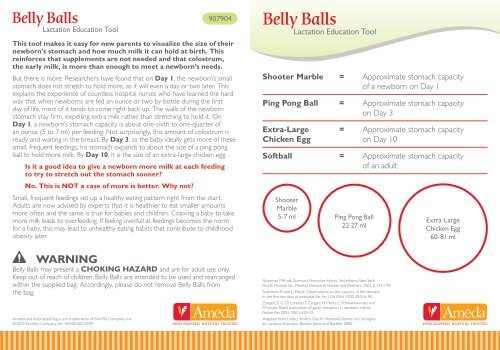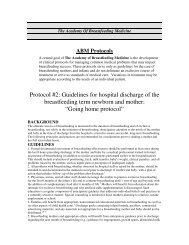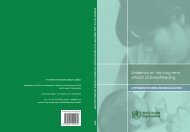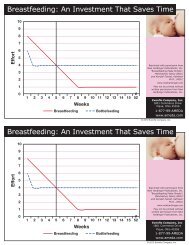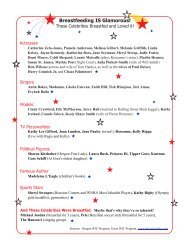Belly Balls - Ameda
Belly Balls - Ameda
Belly Balls - Ameda
Create successful ePaper yourself
Turn your PDF publications into a flip-book with our unique Google optimized e-Paper software.
<strong>Belly</strong> <strong>Balls</strong><br />
Lactation Education Tool<br />
907904<br />
This tool makes it easy for new parents to visualize the size of their<br />
newborn’s stomach and how much milk it can hold at birth. This<br />
reinforces that supplements are not needed and that colostrum,<br />
the early milk, is more than enough to meet a newborn’s needs.<br />
But there is more. Researchers have found that on Day 1, the newborn’s small<br />
stomach does not stretch to hold more, as it will even a day or two later. This<br />
explains the experience of countless hospital nurses who have learned the hard<br />
way that when newborns are fed an ounce or two by bottle during the first<br />
day of life, most of it tends to come right back up. The walls of the newborn<br />
stomach stay firm, expelling extra milk rather than stretching to hold it. On<br />
Day 1, a newborn’s stomach capacity is about one-sixth to one-quarter of<br />
an ounce (5 to 7 ml) per feeding. Not surprisingly, this amount of colostrum is<br />
ready and waiting in the breast. By Day 3, as the baby ideally gets more of these<br />
small, frequent feedings, his stomach expands to about the size of a ping pong<br />
ball to hold more milk. By Day 10, it is the size of an extra-large chicken egg.<br />
Is it a good idea to give a newborn more milk at each feeding<br />
to try to stretch out the stomach sooner<br />
No. This is NOT a case of more is better. Why not<br />
Small, frequent feedings set up a healthy eating pattern right from the start.<br />
Adults are now advised by experts that it is healthier to eat smaller amounts<br />
more often and the same is true for babies and children. Coaxing a baby to take<br />
more milk leads to overfeeding. If feeling overfull at feedings becomes the norm<br />
for a baby, this may lead to unhealthy eating habits that contribute to childhood<br />
obesity later.<br />
<strong>Belly</strong> <strong>Balls</strong><br />
Lactation Education Tool<br />
Shooter Marble = Approximate stomach capacity<br />
of a newborn on Day 1<br />
Ping Pong Ball = Approximate stomach capacity<br />
on Day 3<br />
Extra-Large = Approximate stomach capacity<br />
Chicken Egg on Day 10<br />
Softball = Approximate stomach capacity<br />
of an adult<br />
Shooter<br />
Marble<br />
5-7 ml Ping Pong Ball<br />
22-27 ml<br />
Extra-Large<br />
Chicken Egg<br />
60-81 ml<br />
WARNING<br />
<strong>Belly</strong> <strong>Balls</strong> may present a CHOKING HAZARD and are for adult use only.<br />
Keep out of reach of children. <strong>Belly</strong> <strong>Balls</strong> are intended to be used and rearranged<br />
within the supplied bag. Accordingly, please do not remove <strong>Belly</strong> <strong>Balls</strong> from<br />
the bag.<br />
<strong>Ameda</strong> and associated logos are trademarks of Evenflo Company, Inc.<br />
©2009 Evenflo Company, Inc. 50400160-0409<br />
MOM INSPIRED. HOSPITAL TRUSTED.<br />
Silverman MA, ed. Dunman’s Premature Infants, 3rd edition, New York:<br />
Paul B. Hoeber, Inc., Medical Division of Harper and Brothers, 1961, p 143-144.<br />
Scammon, R. and L. Doyle. Observations on the capacity of the stomach<br />
in the first ten days of postnatal life. Am J Dis Child 1920; 20:516-38.<br />
Zangen, S., C. Di Lorenzo, T. Zangen, H. Mertz, L. Schwankowvsky, and<br />
P. Hyman. Rapid maturation of gastic relaxation in newborn infants.<br />
Pediatr Res 2001; 50(5): 629-32.<br />
Adapted from Linda J. Smith’s, Coach’s Notebook: Games and Strategies<br />
for Lactation Education. Boston: Jones and Bartlett, 2002.<br />
MOM INSPIRED. HOSPITAL TRUSTED.
Bolitas estomacales<br />
herramienta para la lactanci<br />
907904<br />
Esta herramienta facilita a los nuevos padres la visualización del tamaño<br />
del estómago de su recién nacido y de la cantidad de leche que puede<br />
almacenar. Esto refuerza la idea de que los complementos no son<br />
necesarios y que el calostro, la primera leche, es más que suficiente<br />
para satisfacer las necesidades de un recién nacido.<br />
Pero eso no es todo. Los investigadores han descubierto que el primer día, el<br />
pequeño estómago del recién nacido no puede estirarse como lo hará un día o dos<br />
después. Esto explica la experiencia de innumerables enfermeras de hospitales que<br />
han aprendido a la fuerza que cuando se alimenta a los recién nacidos con una onza<br />
o dos (30 o 60 ml) por biberón durante el primer día de vida, la mayor parte vuelve<br />
a salir. Las paredes del estómago de los recién nacidos permanecen firmes, expulsando<br />
la leche que está de más en vez de expandirse para conservarla.<br />
El primer día, la capacidad estomacal de un recién nacido es de aproximadamente<br />
un sexto a un cuarto de onza (5 a 7 ml) por cada vez que se alimenta.<br />
No es casualidad que esa sea la cantidad de calostro que esté listo y esperando<br />
en el pecho. El tercer día, a medida que el bebé va asimilando más de estas<br />
pequeñas cantidades en las frecuentes alimentaciones, su estómago se estira hasta<br />
el tamaño aproximado de una pelotita de ping pong, y puede guardar más leche.<br />
El décimo día, es del tamaño de un huevo extra grande de gallina.<br />
¿Es aconsejable ir aumentando la cantidad de leche que se le da<br />
al recién nacido cada vez que se lo alimenta para intentar estirar<br />
el estómago antes<br />
No, en este caso más NO es mejor. ¿Por qué no<br />
Las alimentaciones cortas y frecuentes establecen un modelo de alimentación<br />
saludable desde el principio. Hoy en día, los expertos aconsejan a las personas<br />
adultas que es más saludable comer en pequeñas cantidades y con más frecuencia,<br />
y lo mismo se aplica a bebés y niños. El obligar a un bebé a tomar más leche lleva<br />
a la sobrealimentación. Si sentirse satisfecho por demás se convierte en rutina para<br />
el bebé, esto puede provocar hábitos de alimentación no saludables que contribuyan<br />
a la obesidad infantil más adelante.<br />
Bolitas estomacales<br />
herramienta de educación<br />
para la lactancia<br />
Canica = capacidad estomacal aproximada<br />
de un recién nacido el primer día<br />
Pelotita de = capacidad estomacal aproximada<br />
ping pong<br />
el tercer día<br />
Huevo extra = capacidad estomacal aproximada<br />
grande de gallina el décimo día<br />
Softball = capacidad estomacal aproximada<br />
de un adulto<br />
Canica<br />
5 a 7 ml Pelotita de<br />
ping pong<br />
22 a 27 ml<br />
Huevo extra<br />
grande de gallina<br />
60 a 81 ml<br />
ADVERTENCIA<br />
Las bolitas estomacales pueden presentar PELIGRO DE ASFIXIA y deben<br />
ser usados por adultos solamente. Mantenga fuera del alcance de los niños.<br />
Las bolitas estomacales están diseñadas para ser usadas y reacomodadas dentro<br />
de la bolsa que se proporciona. Por lo tanto,<br />
no retire las bolitas estomacales de la bolsa.<br />
El logotipo <strong>Ameda</strong> es una marca registrada de Evenflo Company, Inc.<br />
©2009 Evenflo Company, Inc.<br />
MOM INSPIRED. HOSPITAL TRUSTED.<br />
Silverman MA, ed. Dunman’s Premature Infants, 3ª edición, Nueva York:<br />
Paul B. Hoeber, Inc., Medical Division of Harper and Brothers, 1961, págs. 143-144.<br />
Scammon, R. y L. Doyle. Observations on the capacity of the stomach<br />
in the first ten days of postnatal life. Am J Dis Child 1920; 20:516-38.<br />
Zangen, S., C. Di Lorenzo, T. Zangen, H. Mertz, L. Schwankowvsky, y P. Hyman. Rapid<br />
maturation of gastic relaxation in newborn infants. Pediatr Res 2001;<br />
50(5): 629-32.<br />
Adaptado de Coach’s Notebook: Games and Strategies for Lactation Education, de Linda<br />
J. Smith. Boston: Jones and Bartlett, 2002. Boston: Jones and Bartlett, 2002.<br />
MOM INSPIRED. HOSPITAL TRUSTED.


